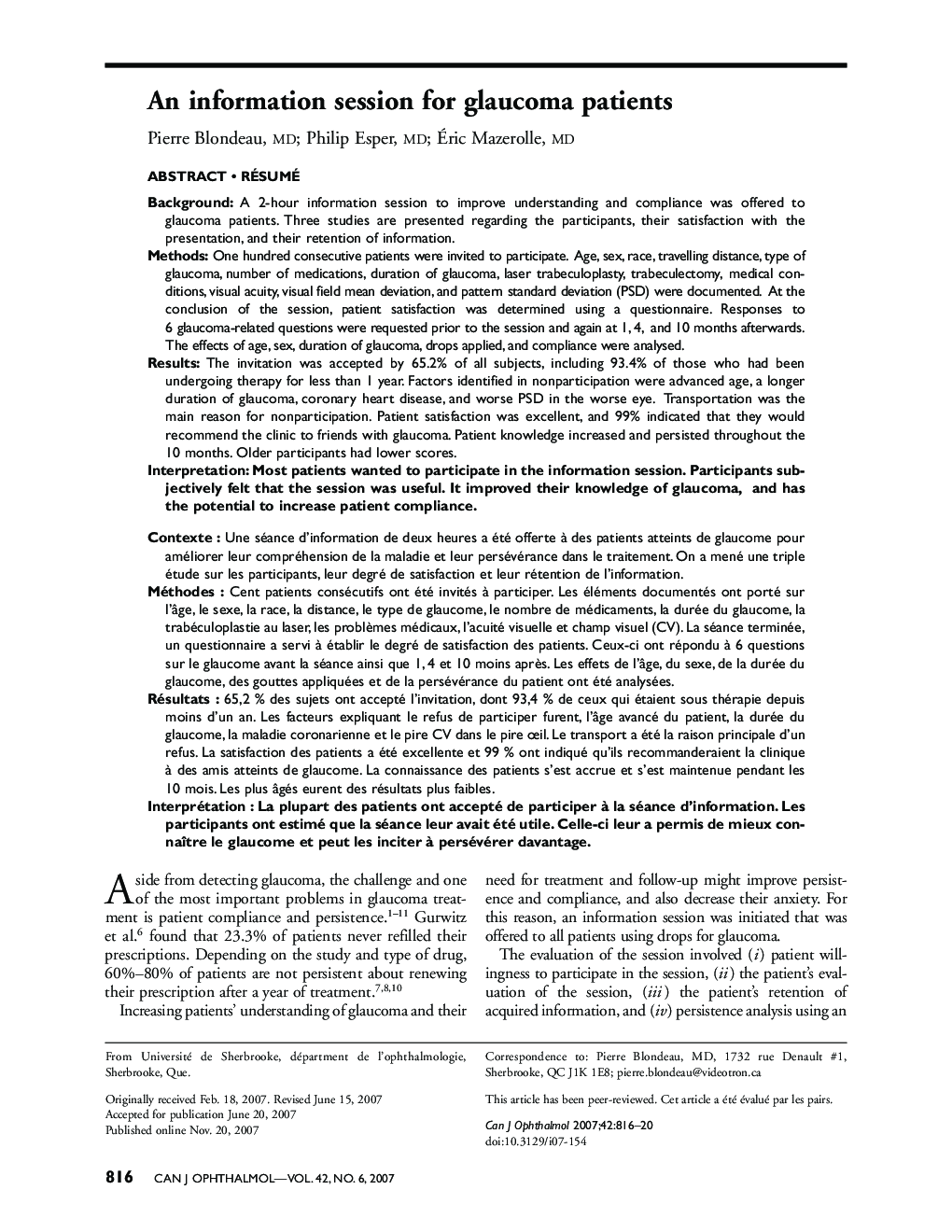| Article ID | Journal | Published Year | Pages | File Type |
|---|---|---|---|---|
| 4010801 | Canadian Journal of Ophthalmology / Journal Canadien d'Ophtalmologie | 2007 | 5 Pages |
Background: A 2-hour information session to improve understanding and compliance was offered to glaucoma patients. Three studies are presented regarding the participants, their satisfaction with the presentation, and their retention of information.Methods: One hundred consecutive patients were invited to participate. Age, sex, race, travelling distance, type of glaucoma, number of medications, duration of glaucoma, laser trabeculoplasty, trabeculectomy, medical conditions, visual acuity, visual field mean deviation, and pattern standard deviation (PSD) were documented. At the conclusion of the session, patient satisfaction was determined using a questionnaire. Responses to 6 glaucoma-related questions were requested prior to the session and again at 1,4, and 10 months afterwards. The effects of age, sex, duration of glaucoma, drops applied, and compliance were analysed.Results: The invitation was accepted by 65.2% of all subjects, including 93.4% of those who had been undergoing therapy for less than 1 year. Factors identified in nonparticipation were advanced age, a longer duration of glaucoma, coronary heart disease, and worse PSD in the worse eye. Transportation was the main reason for nonparticipation. Patient satisfaction was excellent, and 99% indicated that they would recommend the clinic to friends with glaucoma. Patient knowledge increased and persisted throughout the 10 months. Older participants had lower scores.Interpretation: Most patients wanted to participate in the information session. Participants subjectively felt that the session was useful. It improved their knowledge of glaucoma, and has the potential to increase patient compliance.
RésuméContexte: Une séance d’information de deux heures a été offerte à des patients atteints de glaucome pour améliorer leur compréhension de la maladie et leur persévérance dans le traitement. On a mené une triple étude sur les participants, leur degré de satisfaction et leur rétention de l’information.Méthodes: Cent patients consécutifs ont été invités à participer. Les éléments documentés ont porté sur l’âge, le sexe, la race, la distance, le type de glaucome, le nombre de médicaments, la durée du glaucome, la trabéculoplastie au laser, les problèmes médicaux, l’acuité visuelle et champ visuel (CV). La séance terminée, un questionnaire a servi à établir le degré de satisfaction des patients. Ceux-ci ont répondu à 6 questions sur le glaucome avant la séance ainsi que 1,4 et 10 moins après. Les effets de l’âge, du sexe, de la durée du glaucome, des gouttes appliquées et de la persévérance du patient ont été analysées.Résultats: 65,2% des sujets ont accepté l’invitation, dont 93,4% de ceux qui étaient sous thérapie depuis moins d’un an. Les facteurs expliquant le refus de participer furent, l’âge avancé du patient, la durée du glaucome, la maladie coronarienne et le pire CV dans le pire œil. Le transport a été la raison principale d’un refus. La satisfaction des patients a été excellente et 99% ont indiqué qu’ils recommanderaient la clinique à des amis atteints de glaucome. La connaissance des patients s’est accrue et s’est maintenue pendant les 10 mois. Les plus âgés eurent des résultats plus faibles.Interprétation: La plupart des patients ont accepté de participer à la séance d’information. Les participants ont estimé que la séance leur avait été utile. Celle-ci leur a permis de mieux connaître le glaucome et peut les inciter à persévérer davantage.
